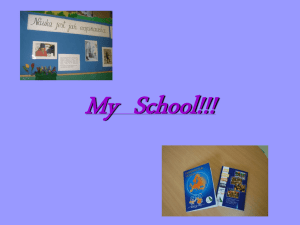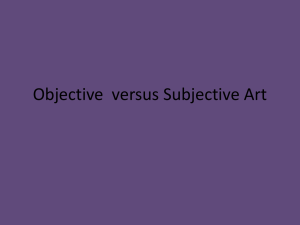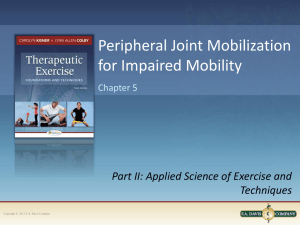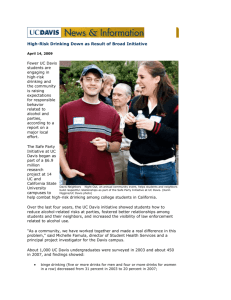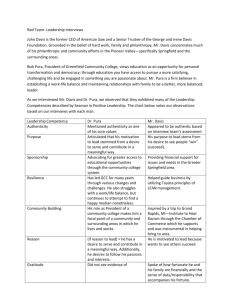Learning Objectives Kid Friendly *I Can* Statements
advertisement
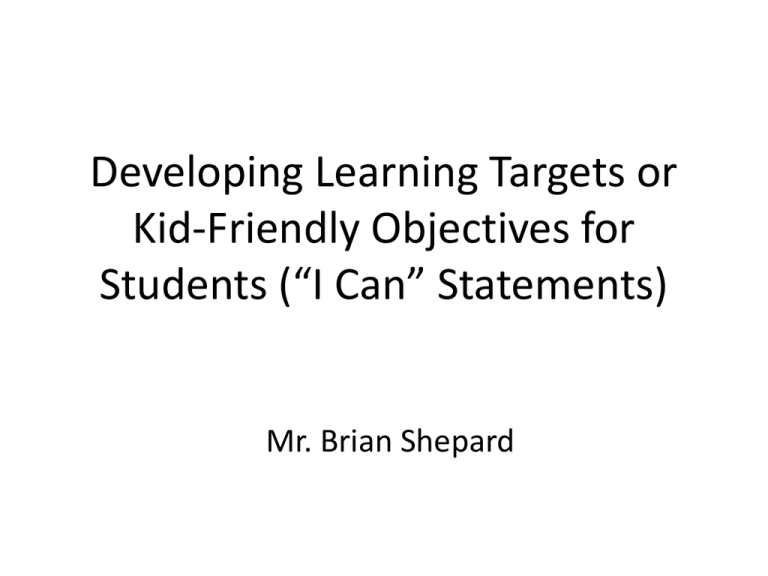
Developing Learning Targets or Kid-Friendly Objectives for Students (“I Can” Statements) Mr. Brian Shepard Presenter Background Davis Junior High School Principal – 2 years Oakbrook Elementary School Principal – 7 years Utica Community Schools Oakland Elementary School Principal – 2 years Addams Middle School Assistant Principal – 3 years Royal Oak School District School Administrator – 14 years Teacher – 5 years Purpose/Goal of Presentation The purpose of this presentation is to provide administrators with information on developing learning targets or “I Can” statements within the building and classroom setting for students and staff. The goal of this presentation is to provide resources and tools for administrators to return to the building and implement this strategy to increase consistency among staff and ultimately improve and impact student achievement. “I Can” Statements for Presentation I can create and construct learning targets within the building and classroom setting for students and staff. I can access resources and provide information to support learning targets for staff. I can develop a consistent message to students and staff within the building to impact student achievement and provide a direction for learning. Packet Contains Copy of Power Point Slides Depth of Knowledge (DOK) Levels Bloom’s Taxonomy Action Verbs Davis Junior High Information • • • • 810 Students (7, 8, 9 grades) 43% Free and Reduced Lunch Sterling Heights, Michigan (Utica Community Schools) Growing EL Population/Growing Diversity Within School District • 2012/2013 School Year (Reward School) • 2013/2014 School Year (Focus School) – New Principal • 2014/2015 School Year (Focus School) 2013/2014 School Initiatives • First Year in Building – Reviewed Current Practices/Lots of Observations and Conversations • Set Three Goals and Shared with Staff (Goal #1 - Build Knowledge Base of Junior High Curriculum Through Evaluation and Instructional Leadership Development, Goal #2 - Build Relationships with Students and Staff Through Visibility, Accessibility and Communication, Goal #3 - Build a Positive and Collaborative Learning Environment • Focused on Building Relationships with Students, Staff and Parents • Rewrote and Focused School Improvement Plan – Peer to Peer and Differentiation Strategies, CITW, AVID • Positive Behavior Support (PBS Planning - MISD) – Rollout 2014/15 • Classroom Instruction that Works (Three year training – MISD) – 14 Staff Members • Made Three Changes – Weekly Staff Newsletter, Staff Meeting Format (One Hour Embedded PD/One Hour Department – Two Hours Total Monthly) and Posting Kid Friendly “I Can” Statements (Raider Red Magnet) • 100% Consistency – “I Can” Statements or Daily Posted Student Friendly Learning Objectives/Targets Why “I Can” Statements for Davis Staff? As a new principal, I did not want to come in and make sweeping changes, but rather strategic moves, so that I would be able to build trust and confidence among the staff. “I Can” Statements would be a building wide strategy that could be included in the school improvement plan as a way to build consistency from classroom to classroom. Part of Classroom Instruction That Works Strategy - “Setting Objectives and Providing Feedback.” Setting daily objectives would provide students with a direction for their learning and could be accomplished consistently throughout the building. The result – 100% staff involvement. 2014/2015 School Initiatives • • • • • • • • • Second Year in Building – Implemented Many Changes Continued to Build Upon Three Goals and Shared with Staff (Goal #1 - Build Knowledge Base of Junior High Curriculum Through Evaluation and Instructional Leadership Development, Goal #2 - Build Relationships with Students and Staff Through Visibility, Accessibility and Communication, Goal #3 - Build a Positive and Collaborative Learning Environment Continued Focus on Building Relationships with Students, Staff and Parents School Improvement Plan – Took Staff Input into Goals and Plans. Focus – AVID, CITW, Department Strategies and Activities Positive Behavior Support (PBS Rollout) – I Can Listen, Learn and Lead)) Classroom Instruction that Works (Three Year Training – MISD) – 14 Staff Members (Year Two) Made Three Changes – Weekly Parent Newsletter, PBS Implementation and Expansion of Kid Friendly “I Can” Statements (Move From Low Level “I Can” Statements to Higher Level with the Addition of Bloom’s Taxonomy/Depth of Knowledge) AEIOU Chart (Continued Consistency Among Classrooms) 100% Consistency – “I Can Statements” or Daily Posted Student Friendly Learning Objectives/Targets – Deeper Statements Consider Classroom Statistics Consider the results of more than 1500 classroom observations: • • • • Clear learning objective – 4% Worksheets – 52% Lecture – 31% Monitoring with little to no feedback – 22% Source – Learning 24/7 (2005) now Teachscape • We realize that there will always be lecture/direct instruction, worksheets (guided or independent practice) and feedback, but how can we establish clear learning objectives that students understand? What Does the Research Say? Research tells us that when students know the expectations, they are more likely to achieve those goals. “I Can” statements empower students, provide a common focus, communicate what is important, build community and engagement and increase motivation and confidence. What Does the Research Say? “The starting place for all effective instruction is designing and communicating clear learning goals.” Robert Marzano (2009) What Does the Research Say? “In most cases neither teachers or students can articulate what they are supposed to be learning that day; they can only describe the activity or assignment.” “There is a glaring absence of the most basic elements of an effective lesson: an essential, clearly-defined learning target.” Mike Schmoker What Does the Research Say? “A recent meta-analysis of 53 research studies (Marzano, 1998) found that when students were clear in advance about what they were learning, their achievement was, on average, 34 percentile points higher on tests used in these studies than students in control groups.” McREL, 2000 What are “I Can” Statements? “I Can” statements are simple sentences designed by a teacher based off of the learning objectives from the curriculum. “I Can” statements are written in student-friendly language. “I Can” statements break down lofty objectives into learning targets students can read and understand. They cover specific learning for each lesson, and there can be more than one “I Can” statement for each common core standard. What are “I Can” Statements? Consider this quote from Rick Stiggins: “Explaining the intended learning in student-friendly terms at the outset of a lesson is the critical first step in helping students know where they are going. Students cannot assess their own learning or set goals to work toward without a clear vision of the intended learning. When they do try to assess their own achievement without understanding the learning targets they have been working toward, their conclusions are vague and unhelpful.” It answers the question: “What part of the larger learning goal are we doing today?” or “What do I want students to carry away today from this lesson?” Stiggins, among others, push “I Can” statements because they are worded in a way that encourages students to measure their own learning. What are “I Can” Statements? When “I Can” statements are used consistently and accurately, they can help students become more responsible for their learning and more reflective of their own work. “I Can” statements also easily transition into assessments and allow for students and teachers to have a better discussion of their work. “I Can” Intended Use Intended Use for Teachers - Connect students with learning targets and communicates the purpose of instruction. (Centers, class meetings, student goal setting, identifying learning targets for explicit instruction, student led conferences and to support EL students (clearly defined goals and combined content and language objectives.)) Intended Use for Students – Provides ownership of their learning and answers the student question, “What do I need to know and be able to do?” (Student data folders, goal setting, progress monitoring, communication tool and student-led conferences.) Intended Use for Parents - Communicate learning targets to parents and answers the question – “Where is my child on the continuum of learning?” (Communication tool to strengthen the home-school partnership, to support learning at home, parent information night, open house, newsletters and conferences.) “I Can” Activity Take the following math common core standard for third grade and break it down in to “kid friendly language.” Remember that “I Can” statements break down lofty objectives into learning targets students can read and understand. “I Can” Activity Examples Strengthening “I Can” Statements Using Bloom’s Taxonomy and DOK Levels to Strengthen ‘I Can” Statements. “I Can” Activity Take two of the CCCS and create an “I Can” Statement. Once you have created one, try to strengthen the “I Can” Statement using the Bloom’s/DOK charts. “I Can” Statement Magnet Classroom Examples Feeder Elementary School Davis Classroom Examples Davis Classroom Examples Davis Classroom Examples Davis Classroom Examples Davis Classroom Examples Davis Classroom Examples Extending “I Can” Statements We have some teachers within the building already skilled with “I Can” statements. Here are some ideas on extending the strategy: • Teachers can state and restate “I Can” statements throughout the lesson. • Teachers can read the “I Can” statements at the beginning of every lesson and can select up to three non-volunteers to restate the learning goal. • Students can restate the “I Can” statements at the end of class as an exit ticket. • As a classroom management tool, teachers can state the “I Can” statement to bring students back together or quiet the class during instructional activities. They can also have students complete this aloud. • Student teams can create “I Can” statements for units and as a class can vote on the favorite one to display. Setting Objectives – Classroom Instruction that Works Setting Objectives –Bringing the Strategy to Life • Recommendation One – Set learning objectives that are specific, but not restrictive (Know, Understand, Do) • Recommendation Two – Communicate the learning objectives to students and parents? (Post, Discuss, Reference) • Recommendation Three – Connect the learning objectives to previous and future learning • Recommendation Four – Engage students in setting personal learning objectives CITW Training, 2014 Setting Objectives – Classroom Instruction that Works Reflection/Take-away from Strategy/Things to Share with Teachers Does your “I Can” statement capture the following information? (What the Students Need to Know, Understand, Do?) Do 90% of the students in the classroom know where the learning objective is listed? Do you list the learning objective on student assignments? How are you communicating this to parents? Extending “I Can” Statements to Tracking Student Growth and Learning Next Steps Have conversations with staff about how they communicate their learning expectations to students. Start with a teacher, grade level, or department. Select a visual (magnet, mascot) for consistency from classroom to classroom. Start small and identify the learning expectation for the content area and transform to student friendly version. Learning targets take time and effort. Display the “I Can” magnet on your whiteboard/bulletin board in classroom. Create “I Can” statements and extend the strategy as needed. Revisit often with staff, make it part of your culture. Next Steps “I Can” Statements – Every day, every room (Consistency across classrooms, departments, building.) Extend the “I Can” in your classroom through one of the listed ideas or one of your own. Charlotte Danielson Evaluation System - (Domain 3a: Communicating with Students – The teacher links the instructional purpose of the lesson.) Charlotte Danielson Evaluation System - Think about how students are tracking their progress in the classroom. Are students actively tracking their progress? (Domain 4b: Maintaining Accurate Records – Students contribute information and participate in maintaining the records (Students contribute to and maintain data files indicating their own progress in learning.)) Impact in Other Areas The simple learning target or “I Can” may lead to other items within the school. Example – PBS (Respect, Responsibility, Safety) Impact in Other Areas The simple learning target or “I Can” may lead to other items within the school. Example – AEIOU (Citizenship/Engagement/Effort) – Used in Earned Privilege Program. “I Can” Statement Website Resources • http://www.wapsievalleyschools.com/guaranteed-to-learn • http://resa2.k12.wv.us/wvcso.asp • http://www.wcde.org/education/components/docmgr/default.php?sectio ndetailid=24351&&PHPSESSID=5997c5838ae2c28510cca9d68b3ac203 • http://www.maysville.k12.oh.us/domain/190 • http://www.etown.k12.ky.us/Instructional-Links.asp • http://lakeviewelementarywy.wikispaces.com/Learning+Focused+-+KUD++I+Can+Statements • http://www.boyertownasd.org/Page/1165 Questions? Brian Shepard Brian.Shepard@uticak12.org
